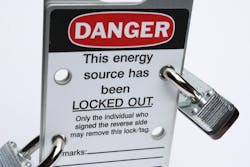A critical system went down, and you respond to the call. The operations supervisor tells you he’ll go ahead and lock everything out to save you time. Your assistant balks at this and says the two of you will do your own lockout/tagout. That annoys the operations supervisor, who replies by stressing how much revenue is being lost every minute this system is down.
How do you handle this? Who is right?
A good way to handle this is to ask the operations supervisor the following question. “Can you hang a hasp on the relevant locks, then walk us through the whole lockout/tagout using our drawings so we don’t miss anything?”
So while you’re doing other preparation work, they go ahead of you and hang their locks and tags on those hasps. And because they know the physical location of each energy source they locked out, you will save time by not having to hunt for things.
All without putting your safety at risk. But it’s very important that you’re actually walking through the system (not just checking their walk-through as if it’s complete) to ensure you’ve accounted for every relevant energy source. Missing even one can result in serious injury or death.
Operations can remove their tags and locks any time they want, but yours will be removed when the removal is safe for you.
In some facilities, the “proof” part is reversed from this example. An operator walks through the lockout/tagout with the technicians, who must prove to the operator the correct breaker or other disconnecting device is correctly locked out for each relevant energy source. You get permission to proceed only when the operator signs off.
Other ways operators can help include moving boxes or other obstacles out of the work area, setting up lights, operating a lift truck if needed (for example, a motor change), roping off the work area, removing parts in progress from the equipment, performing functional tests, and helping you clean up the area when the job is done.
But simply taking over your lockout/tagout is not something you should ever permit another department or even another person to do. Always do that yourself. Having another set of eyes to verify is good, but your own eyes need to be on every energy source that could endanger you while you are performing a repair.
Here’s an additional tip: Consider using personalized tags. Not just generic tags that you hand-write your name on, but tags that have your photo and contact information on them. Using these tags helps get across the point that a real person depends on them. And also, you’ll be easier to locate if anyone has questions.
About the Author

Mark Lamendola
Mark is an expert in maintenance management, having racked up an impressive track record during his time working in the field. He also has extensive knowledge of, and practical expertise with, the National Electrical Code (NEC). Through his consulting business, he provides articles and training materials on electrical topics, specializing in making difficult subjects easy to understand and focusing on the practical aspects of electrical work.
Prior to starting his own business, Mark served as the Technical Editor on EC&M for six years, worked three years in nuclear maintenance, six years as a contract project engineer/project manager, three years as a systems engineer, and three years in plant maintenance management.
Mark earned an AAS degree from Rock Valley College, a BSEET from Columbia Pacific University, and an MBA from Lake Erie College. He’s also completed several related certifications over the years and even was formerly licensed as a Master Electrician. He is a Senior Member of the IEEE and past Chairman of the Kansas City Chapters of both the IEEE and the IEEE Computer Society. Mark also served as the program director for, a board member of, and webmaster of, the Midwest Chapter of the 7x24 Exchange. He has also held memberships with the following organizations: NETA, NFPA, International Association of Webmasters, and Institute of Certified Professional Managers.
